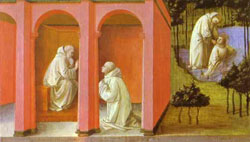
Feastday: October 5
Patron: of Messina (co-patron), Biancavilla, Castel di Lucio, Montecarotto, Poggio Imperiale
Death: 6th century
Disciple of St. Benedict at Subiaco and Monte Cassino. He is known mainly through the Dialogues of Pope St. Gregory I the Great and is closely associated with St. Maurus of whom little is known outside of legend and the Dialogues . The son of a patrician named Tertulus, the very young Placid was placed into the care of St. Benedict at Subiaco, supposedly being saved from drowning through the aid of the renowned saint. Placid subsequently accompanied Benedict to Monte Cassino, which was evidently given to Benedict by the obviously grateful Tertulus. The name Placid was thereafter attached to assorted legends, including one assigning him credit for founding St. John the Baptist Monastery at Messina, in Sicily. While there, he was said to have been martyred by Saracen raiders with two brothers, a sister, and thirty companions. It is known that he was never in Sicily, and the bones discovered in 1585 at the monastery and widely believed to be Placid's are not, in fact, his. Among his disciples are counted Eutychius, Faustus, Donatus, and Firmatus.
- For the martyr of this name, see Saint Placidus (martyr).
Saint Placidus (also known as Saint Placid) was a disciple of Saint Benedict. He was the son of the patrician Tertullus, was brought as a child to St. Benedict at Sublaqueum (Subiaco) and dedicated to God as provided for in chapter 69 of the Rule of St. Benedict (oblate).
Life
Placidus was the eldest son of the patrician Tertullus. When he was about eight years old, his father placed him under the care of St. Benedict at Subiaco, to be educated. Saint Gregory the Great (Dialogues, II, vii) relates an account of Placidus being rescued from drowning by his fellow monk, Saint Maurus, when, at Saint Benedict's order ran across the surface of the lake below the monastery and drew Placidus safely to shore. It appears certain that he accompanied Saint Benedict when, about 529, he removed to Monte Cassino, which was said to have been made over to him by the father of Placidus.
Of his later life nothing is known, but in an ancient psalterium at Vallombrosa his name is found in the Litany of the Saints placed among the confessors immediately after those of Saint Benedict and Saint Maurus; the same occurs in Codex CLV at Subiaco, attributed to the ninth century.
Veneration
He is venerated together with Saint Maurus on 5 October.
Patronage
He is the co-patron of Messina along with the Madonna of the Letter, and is the official patron of Biancavilla, Castel di Lucio, Montecarotto, and Poggio Imperiale. Because a large portion of Easton, Pennsylvania's Italian community originally came from Castel di Lucio, Saint Placidus is given particular veneration with an annual parade through South Side on the Sunday before Labor Day. The Sunday after is the Feast of the Holy Cross, celebrated by immigrants from the neighboring town of Santo Stefano di Camastra.

